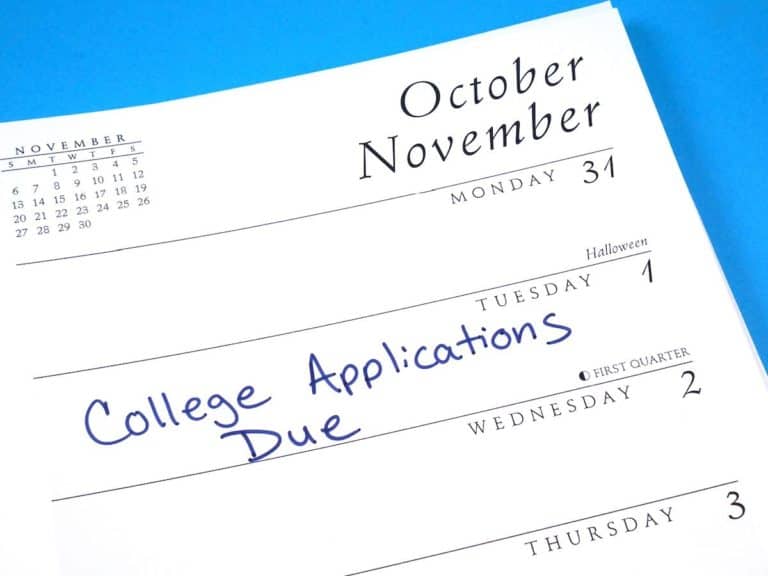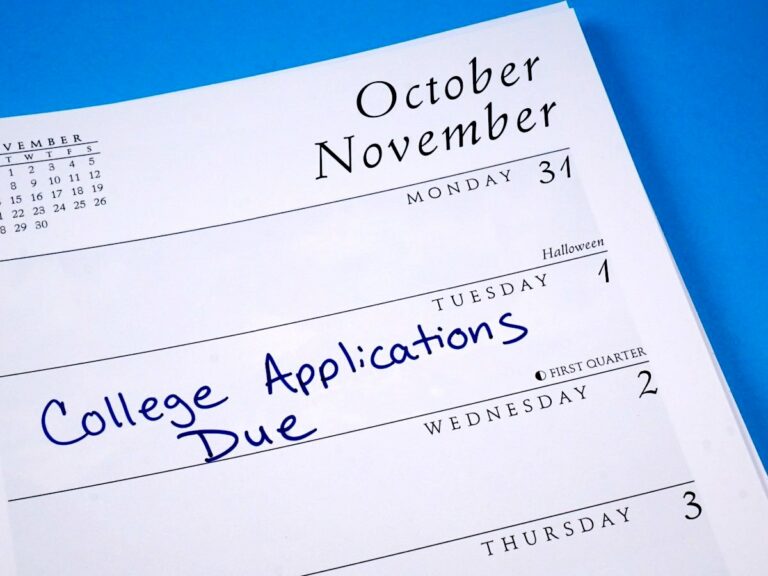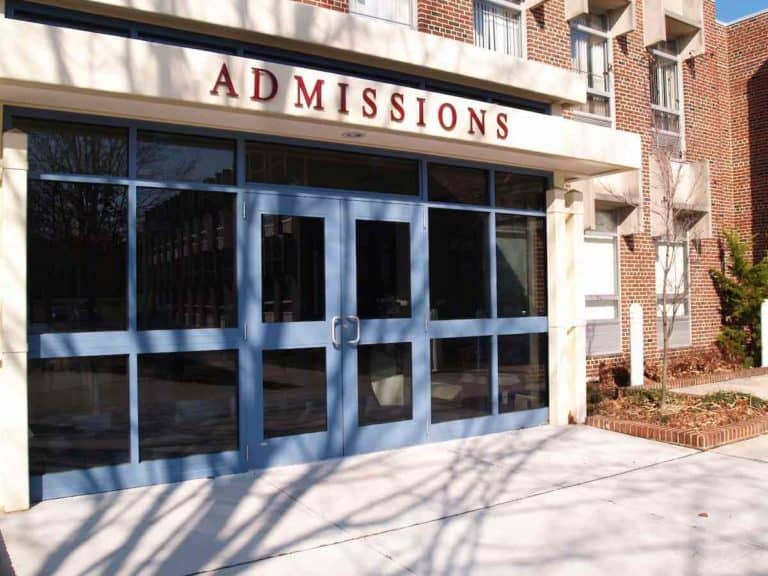College Application Deadlines Explained
A National Center for Education Statistics (NCES) report says that 15.4 million students in the United States go to colleges and universities each year.
Getting accepted to the higher education institution that you like begins with submitting the Common App or Coalition App to the admissions office on time.
You can choose from different admission plans, each one has a different deadline for submission.
The vast majority of students apply regular decision (RD), which has a later deadline than early decision (ED) and early action (EA).
Some schools have a rolling admissions (RD) policy, which has no hard deadline.
It’s not enough that you apply to the right college — it’s also a must that you apply to it in a timely manner.
Continue reading if the college application cycle is nearing. In this post, I will help you navigate the various admission plans that colleges and universities in the country offer.

Different College Application Deadlines
Different institutions have different college application deadlines.
They include Early Action, Restrictive Early Action, Priority Deadline, Early Decision, Regular Decision, and Rolling Admission.
Each college decision plan has a different deadline, which can vary from one institution to the other.
One of the things that make the college application process challenging is knowing which institutions to send applications to. Another one that makes it tricky is knowing WHEN to submit those applications.
College-bound high school students would experience less headaches if application deadlines for all institutions for higher education in the US were all the same.
Unfortunately, it’s far from reality. That’s because there are all sorts of decision plans to choose from. What’s more, the deadline for each decision plan can vary from one school to the other.
Let’s check out the different college application deadlines you need to know by heart:
Early Action (EA)
Like the name suggests, Early Action is a decision plan with an early deadline and decision, too. The majority of Early Action deadlines are in November. However, some colleges and universities have Early Action deadlines in October or December.
What’s nice about Early Action is that it’s non-binding.
So, in other words, you don’t have to enroll at the school that accepts you via Early Action. In addition, you can apply to different colleges and universities Early Action.
And because you apply earlier than everybody else, you might enjoy increased admissions chances.
Restrictive Early Action (REA)
Sometimes called Single Choice Early Action (SCEA), Restrictive Early Action is just like Early Action.
However, there is a catch: you may not apply to other institutions via any early decision plan — Early Action, Early Decision, and Restrictive Early Action. But there’s a couple of good news.
First, you can still send applications to various schools through Regular Decision.
Second, similar to EA, Restrictive Early Action is non-binding.
Related Article: How is Early Decision Enforced? Myths and Facts

Priority Deadline (PD)
Many students think that Priority Deadline is just a fancy name for Early Action.
While there are similarities between the two decision plans alright, such as deadlines and increased chances of gaining admission into a college or university, there is one thing that sets Priority Deadline apart from ED: students who apply through it are given top consideration.
By the way, Priority Decision is non-binding, which means you can enroll elsewhere if you get accepted.
Early Decision (ED)
Like EA, REA, and PD, Early Decision has an early deadline. However, it’s a restrictive decision plan due to the fact that it’s binding.
This means that you have to withdraw your applications from other colleges and universities and then enroll at the institution that accepts you through Early Decision.
Selective schools, most of the time, are those that offer Early Decisions.
Also, many of them offer two rounds of this decision plan (ED I and ED II) to give students who wish to commit to them plenty of time to submit their applications.
Related Article: Is Early Decision Worth It? All Pros and Cons
Regular Decision (RD)
Simply put, Regular Decision is the standard college application process.
Regular Decision deadlines can range anywhere from November to February, but some institutions can have other deadlines.
The perks of applying in Regular Decision include having the opportunity to improve the GPA, retake the SAT or ACT, perfect one’s admissions essay, and build a better list of colleges and universities to apply to.
However, applying Regular Decision can get in the way of your final exams, especially if you intend to apply to many schools.
Rolling Admission (RA)
Institutions with a Rolling Admission decision plan evaluate applications as they are received.
Some Rolling Admission schools do not have deadlines, while others have, although they are late, most of the time.
Just because you wish to apply Rolling Admission doesn’t mean that you should not act fast.
That’s because colleges and universities offering this decision plan still abide by the “first come, first served” rule.
So, in other words, if there are no more slots available, it’s likely for you to be rejected even if you have an impressive application.
Those are the different college application deadlines. But…
It’s not enough that you are familiar with the various decision plans. It’s also a must that you know the deadline for each one of them.
As mentioned earlier, the deadline for one decision plan can differ from institution to institution.
It’s because of this why you should carefully research the deadlines for your chosen colleges or universities.
Here are the various college application deadlines for flagship schools in the US:
| UNIVERSITY | Early Action | Priority Deadline | Regular Decision | |
|---|---|---|---|---|
| Indiana University Bloomington | Nov. 1 | – | Feb. 1 | |
| Louisiana State University | – | Dec. 15 | Feb. 1 | |
| Ohio State University | Nov. 1 | – | Feb. 1 | |
| Purdue University | Nov. 1 | Mar. 1 | Jan. 15 | |
| Rutgers University | Nov. 1 | – | Dec. 1 | |
| Texas A&M University | Oct. 15 | – | Dec. 15 | |
| University at Buffalo | Nov. 15 | – | Feb. 1 | |
| University of Alabama | – | – | Early July | |
| University of Alaska Fairbanks | – | – | 15-Jun | |
| University of Arizona | – | Mar. 1 | 1-May | |
| University of Arkansas | Nov. 1 | – | Nov. 1 | |
| University of California, Berkeley | – | – | Nov. 30 | |
| University of Colorado Boulder | Nov. 15 | – | Jan. 15 | |
| University of Connecticut | Dec. 1 | – | Feb. 1 | |
| University of Delaware | Nov. 1 | – | Jan. 15 | |
| University of Florida | – | Nov. 1 | Mar. 1 | |
| University of Georgia | Oct. 15 | – | Jan. 1 | |
| University of Hawaii at Manoa | – | Jan. 5 | Mar. 1 | |
| University of Idaho | – | – | 1-May | |
| University of Illinois Urbana – Champaign | – | Nov 1 | Jan. 5 | |
| University of Iowa | – | – | Apr. 1 | |
| University of Kansas | Nov 1. | – | 1-May | |
| University of Kentucky | Dec. 1 | – | Feb. 15 | |
| University of Maine | Dec. 1 | – | Mar. 1 | |
| University of Maryland, College Park | Nov. 1 | – | Jan. 20 | |
| University of Massachusetts Amherst | Nov. 5 | – | Jan. 15 | |
| University of Michigan | Nov. 1 | – | Feb. 1 | |
| University of Minnesota | Nov. 1 | – | Jan. 1 | |
| University of Mississippi | – | – | 20-Jul | |
| University of Missouri | – | – | Nov. 15 | |
| University of Montana | – | – | 31-Jul | |
| University of Nebraska – Lincoln | – | – | 1-May | |
| University of Nevada – Reno | Nov. 15 | – | Apr. 7 | |
| University of New Hampshire | Nov. 15 | – | Feb. 1 | |
| University of New Mexico | – | – | 15-Jun | |
| University of North Dakota | – | – | Aug. 16 | |
| University of Oklahoma | Nov. 1 | – | Feb. 1 | |
| University of Oregon | Nov. 1 | – | Jan. 15 | |
| University of Rhode Island | Dec. 1 | – | Feb. 1 | |
| University of South Carolina | Oct. 15 | – | Dec. 1 | – |
| University of Texas at Austin | Nov. 1 | – | Dec. 1 | |
| University of North Carolina at Chapel Hill | Oct. 15 | – | Jan. 15 | |
| University of Utah | Dec. 1 | – | Apr. 1 | |
| University of Vermont | Nov. 1 | – | Jan. 15 | |
| University of Virginia | Nov. 1 | – | Jan. 3 | |
| University of Washington | – | – | Nov. 15 | |
| University of Wisconsin – Madison | Nov. 1 | – | Feb. 1 | |
| University of Wyoming | – | – | 1-Jun | |
| West Virginia University | – | – | Aug. 1 |
Note: While we are trying our best to provide accurate information, please check the dates with individual institutions to make sure that they have not changed since publication.
How Do You Know College Application Deadlines?
One of the quickest ways to know college application deadlines is by consulting with the high school counselor.
Visiting the college’s website, contacting the college’s admissions office via email, subscribing to the mailing list, and checking out admissions flyers and brochures may be done, too.
When it comes to applying to colleges and universities, completing your application is just half the battle. The other half is all about submitting your application in a timely manner.
A school will still receive your application if you submit it past the deadline.
However, it is completely up to the institution if your application will be considered. If there are a lot of amazing applicants, your application might be disregarded. But if you have something wonderful to offer as a student, your application might be accepted.
Because it is the next four years of your academic life that are on the line, it’s a must to be aware of deadlines.
There is someone in your high school who can lend a hand regarding this matter: the counselor. Your high school counselor is one of the busiest people on the campus during the college application season.
It’s no secret that a high school counselor is the one who sends out transcripts to various colleges and universities.
He or she is also someone who writes recommendation letters, especially for students who are applying to institutions requiring at least one letter of recommendation to be written by the high school counselor.
Besides the tasks mentioned above, your high school counselor can also help you:
- Create a list of institutions to apply to. Your high school counselor can assist you in shortlisting colleges and universities based on your interests and financial needs. With his or her help, you can avoid applying to schools that don’t fit you, thus helping you avoid unnecessary application costs and frustrations, too.
- Explain the requirements of each school. Different schools require applicants to meet different requirements and submit different documents. A high school counselor can help save you from submitting the right things to the wrong schools, thus helping to make your college application go as smoothly as possible.
- Alleviate anxiety and boost morale. The college application season is one of the busiest times for high school students. It’s one of the most stressful and worrisome, too. You can approach your high school counselor if you find the college application process taxing and you feel like you are getting nowhere.
Since a high school counselor is a busy bee when all the junior and senior students at your high school are engaged with applying to colleges and universities, you may have to learn about college application deadlines through other means at times.
For instance, instead of heading to the high school counselor’s office, you may pay college websites a visit.
It’s for certain that you will come across college application deadlines on the Admissions page.
Make sure that you read application deadlines for incoming freshmen. That’s because college application deadlines tend to differ for new students, transferees and graduate students.
You may also get in touch with someone from the Admissions Office via email or phone.
What’s nice about this is that you get to obtain application deadline-related details from a person who knows them very well.
College flyers, brochures and posters are also likely to talk about college application deadlines.
Related Article: Early Decision Strategy for Getting Admitted to Best College

What are Late College Application Deadlines?
Late college application deadlines are for students who fail to submit their applications on time.
Some colleges and universities have late college application deadlines that extend into June, July, and even August.
Most institutions with late college application deadlines are not competitive.
Above, we established the fact that different colleges offer different college application deadlines.
Despite the availability of many decision plans whose RD deadlines usually range anywhere from November to January, unfortunately, not all college-bound kids can submit their applications on time.
Just because a student is looking for institutions with late college application deadlines doesn’t mean that he or she is lazy.
There are different reasons why some high schoolers are unable to apply to colleges and universities on schedule. As a matter of fact, some of them deliberately apply late.
Here are some of those who could benefit from the availability of late college application deadlines:
- Those who wish to take the SAT or ACT again to get better scores because the institutions they like to apply to do not have a test-optional admissions policy.
- Those who believe that their grades for the very last semester of their high school can increase their GPA, thus allowing them to gain admission into better colleges.
- Those who like to include more institutions on their list, usually because of getting a rejection letter from the schools they applied to via Early Decision.
- Those who encountered a family emergency or an unforeseen circumstance that has kept them from completing and submitting their applications punctually.
But then there are also students who are applying to colleges and universities late simply because they are not too serious or keen about earning a degree.
Well, that could be a problem since it’s not unlikely for the admissions officers to probe why they were unable to beat the deadline.
As mentioned earlier, most schools that accept late applicants are not the most competitive.
Despite this, they are still accredited institutions, and thus the degrees you can earn from them are respected by employers.
But some prestigious schools have late college application deadlines, too, such as Hampton University and Wesleyan College.
Here are a few examples of the many institutions with late college application deadlines:
| UNIVERSITY | LATE DEADLINE |
|---|---|
| Abilene Christian University | February |
| Baylor University | February |
| Ithaca College | February |
| Morehouse College | February |
| Spelman College | February |
| Georgia State University | March |
| Illinois State University | March |
| Lewis & Clark College | March |
| Roanoke College | March |
| SUNY University at Albany | March |
| Temple University | March |
| Georgia College and State University | April |
| Keene State College | April |
| University of Massachusetts Boston | April |
| Austin College | May |
| Bard College at Simon’s Rock | May |
| Clemson University | May |
| Worcester State University | May |
| Central Connecticut State University | June |
| Columbus State University | June |
| Jacksonville University | June |
| Mercy College of Health Sciences | June |
| Wesleyan College | June |
| Albany State University | July |
| Black Hills State University | July |
| Cincinnati Christian University | July |
| Coppin State University | July |
| Silicon Valley University | July |
| Alaska Pacific University | August |
| Auburn University at Montgomery | August |
| Belmont Abbey College | August |
| Huntington University | August |
| Maryville University of Saint Louis | August |
Application Deadline for Colleges
We pointed out some of the pros of late college application deadlines — for a higher SAT or ACT score, better GPA, addition of other schools on the list.
However, there are also some downsides that come with applying to an institution much later than everybody else.
Some of them include:
- It could look like you are not that interested in going to college.
- The options for prestigious colleges are considerably limited.
- Failure to obtain competitive financial aid.
Now that you know the different college application deadlines, you can focus more on perfecting your application and less on worrying about missing deadlines.
Good luck applying!
Related Article: Can You Get Into College Without Extracurriculars?
Disclaimer: The views and opinions expressed in this article are those of the authors and do not necessarily represent those of the College Reality Check.





